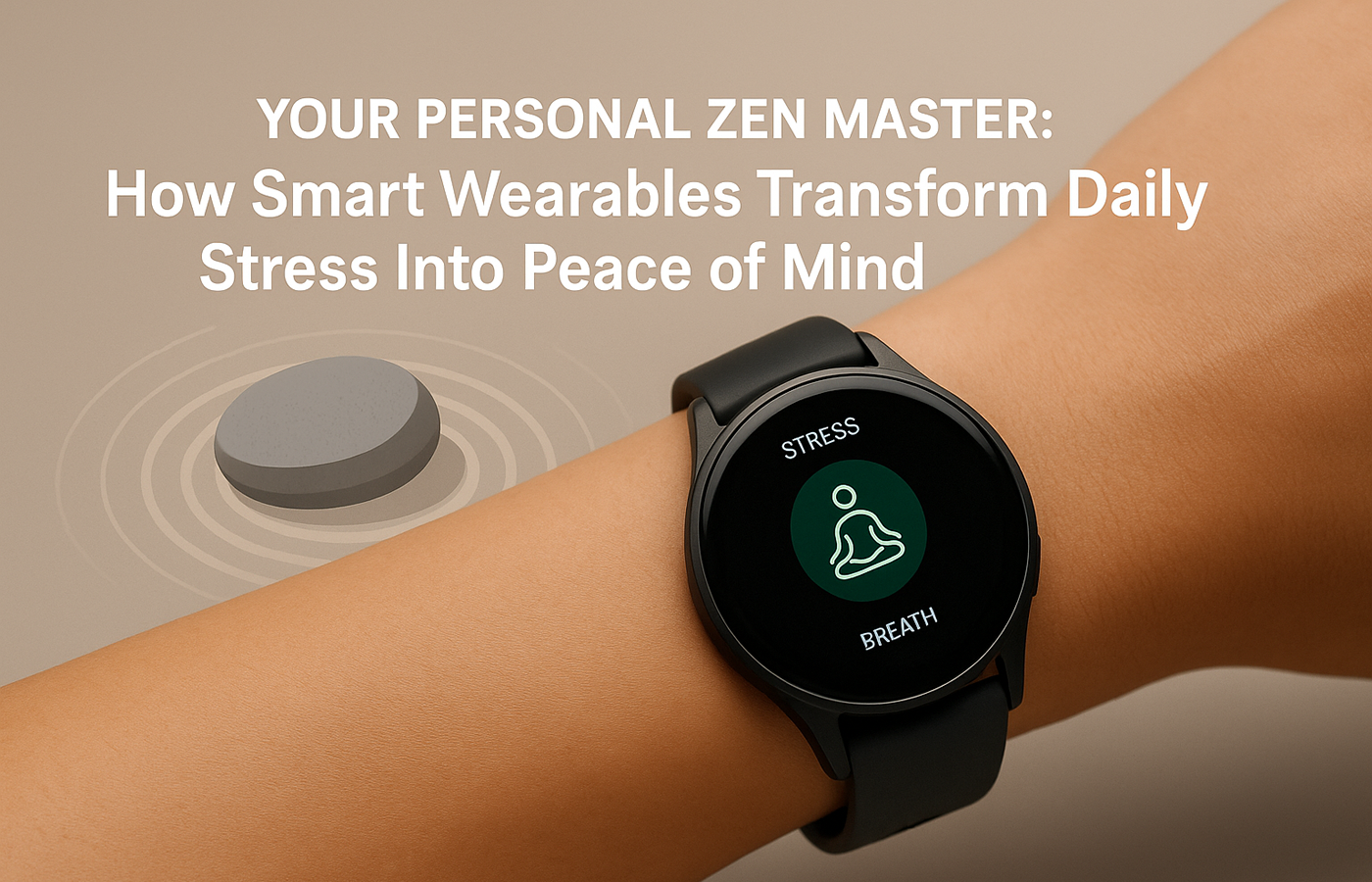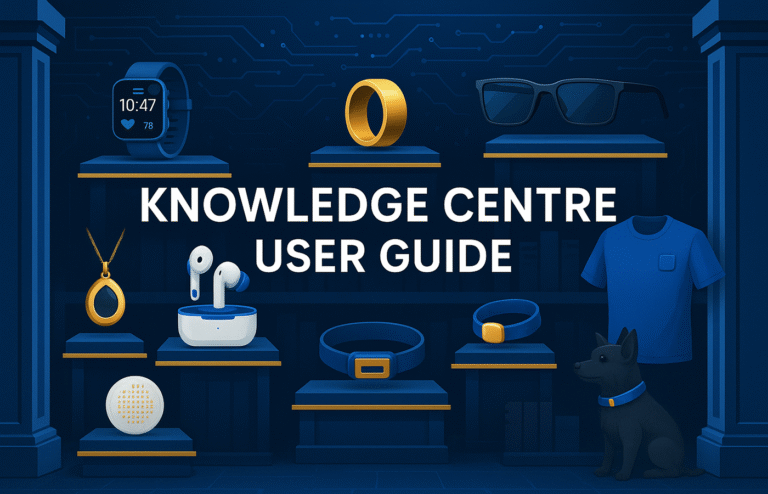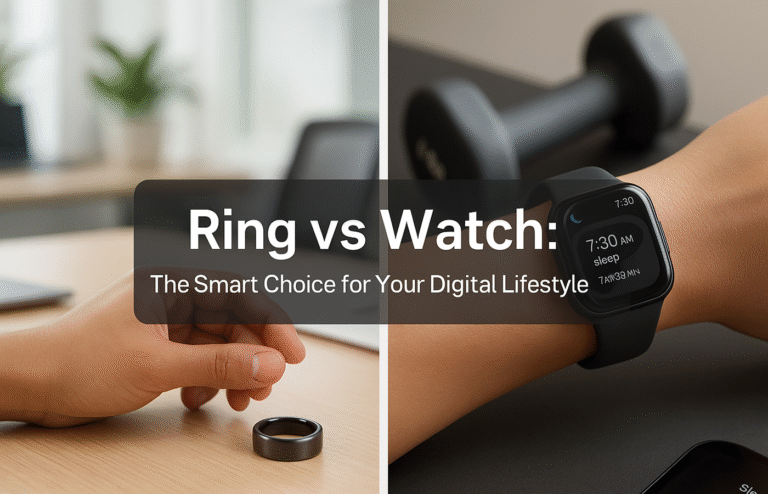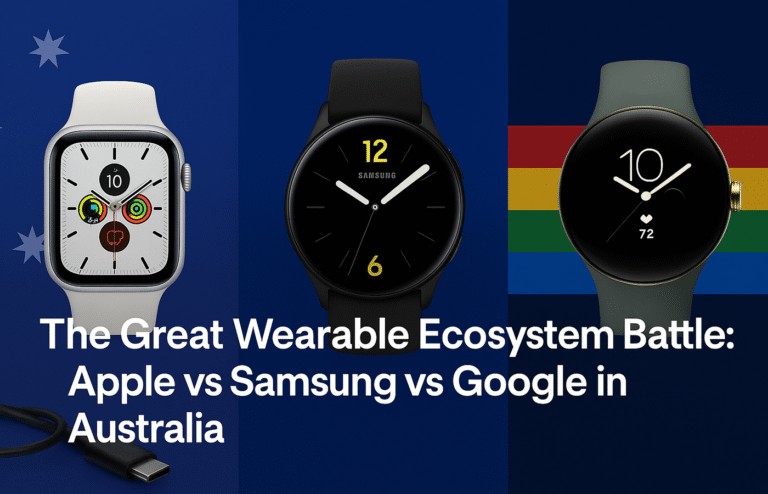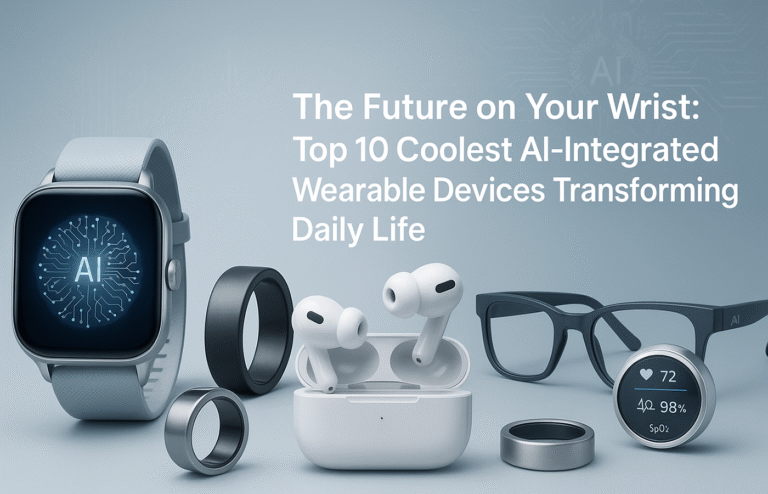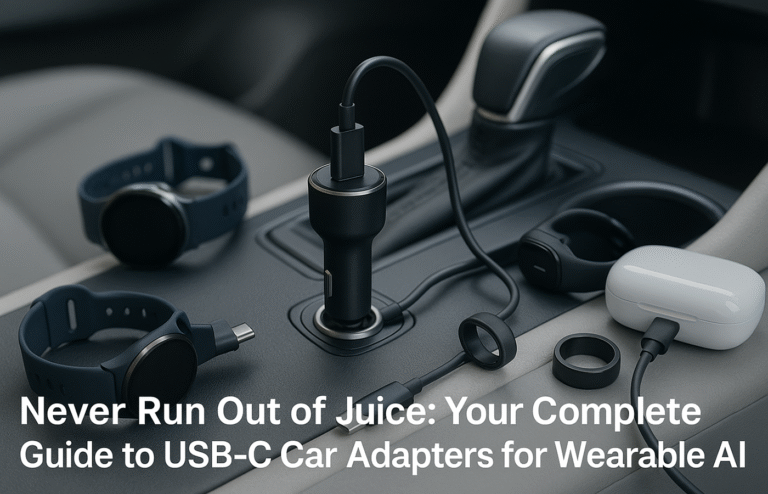Stressed to Blessed: How Wearable AI Transforms Daily Stress Management for Australians
Smart wearables detect stress through physiological signals and provide real-time interventions, helping manage anxiety affecting over 2 million Australians annually through continuous monitoring and guided breathing.
Stress Detection Technology:
● Heart rate variability monitoring identifies nervous system shifts from calm to stressed states
● Electrodermal activity sensors in devices like Fitbit Sense 2 measure skin conductance changes
● Temperature fluctuations and movement patterns provide additional stress indicators
Leading Devices and Pricing:
● Apple Watch SE ($399) or Series 10 ($649): Excellent mindfulness app with guided breathing sessions
● Fitbit Sense 2 ($350-400): Advanced EDA sensors with 6+ day battery life
● Oura Ring 4 ($549-649): Continuous monitoring without wrist bulk, exceptional recovery insights
Real-Time Interventions:
● Guided breathing exercises with haptic feedback and visual guidance
● Personalised mindfulness prompts for gratitude and perspective shifting
● Pattern recognition identifying stress triggers and optimal intervention timing
Your Personal Zen Master: How Smart Wearables Transform Daily Stress Into Peace of Mind
It’s 2:30 PM on a Wednesday, and you’re staring at your computer screen whilst your mind races through an endless to-do list. Your shoulders are tense, your breathing is shallow, and that familiar knot in your stomach is tightening. Suddenly, your wrist gently vibrates with a message: “It looks like you’re experiencing stress. Would you like to take a moment to breathe?”
This isn’t a futuristic fantasy—it’s happening right now on the wrists of thousands of Australians who’ve discovered that managing daily anxiety and stress doesn’t require expensive therapy sessions or meditation retreats. Instead, the solution might be as simple as wearing the right piece of technology that learns your stress patterns and guides you toward calm, one breath at a time.
The Hidden Epidemic of Daily Stress
Before exploring how technology can help, it’s important to understand just how pervasive stress has become in modern Australian life. According to Beyond Blue, anxiety disorders affect over 2 million Australians each year, whilst workplace stress costs the Australian economy billions annually in lost productivity and healthcare expenses.
However, most of us don’t need statistics to know that daily life feels more overwhelming than ever. Between demanding work schedules, family responsibilities, financial pressures, and the constant buzz of digital notifications, our nervous systems are chronically activated in ways our ancestors never experienced.
The challenge isn’t just managing major stressful events—it’s dealing with the constant low-level anxiety that accumulates throughout ordinary days. This is where wearable AI technology shines, offering continuous monitoring and intervention right when you need it most.
How Your Wrist Knows You’re Stressed Before You Do
Modern wearable devices have become surprisingly sophisticated at detecting stress through various physiological signals that change when your body’s fight-or-flight response activates.
Heart Rate Variability: The Secret Window Into Your Nervous System
The most powerful tool in a wearable’s stress-detection arsenal is heart rate variability (HRV) monitoring. Contrary to popular belief, a healthy heart doesn’t beat like a metronome—instead, there should be subtle variations in the time between beats. When you’re relaxed, these variations increase. When you’re stressed, they decrease dramatically.
Devices like the Fitbit Sense 2 (approximately $350-400 AUD) and Apple Watch Series 10 ($649 RRP) continuously monitor these tiny fluctuations, building a personalised baseline of your stress responses. Over time, they become remarkably accurate at identifying when your nervous system shifts from calm to activated, often before you consciously realise you’re feeling stressed.
Skin Conductance: Reading Your Body’s Electrical Story
Advanced devices like the Fitbit Sense 2 include electrodermal activity (EDA) sensors that measure tiny electrical changes in your skin. When you’re stressed, anxious, or emotionally activated, your skin’s conductance changes in measurable ways. This technology, originally used in medical settings, now fits comfortably on your wrist and provides real-time insights into your emotional state.
Temperature and Movement Patterns
Your body temperature fluctuates throughout the day, but stress can cause specific changes that wearables can detect. Similarly, when anxious, people often exhibit subtle changes in movement patterns—perhaps fidgeting more, breathing differently, or adopting tense postures that accelerometers can identify.
Real-Time Breathing Interventions That Actually Work
Once your wearable detects stress, the real magic happens through guided breathing interventions that can rapidly shift your nervous system from fight-or-flight back to a calm state.
The Apple Watch Mindfulness Revolution
The Apple Watch’s built-in Mindfulness app (formerly called Breathe) represents one of the most accessible stress management tools ever created. When stress is detected—or at scheduled intervals throughout the day—the watch gently taps your wrist and invites you to engage in a breathing session.
The visual interface is beautifully simple: animated circles expand and contract, guiding you to inhale as they grow and exhale as they shrink. Meanwhile, haptic feedback provides gentle pulses that help you maintain rhythm even with your eyes closed. Sessions can last anywhere from one to five minutes, making them practical for busy schedules.
Sarah Mitchell, a marketing executive from Melbourne, describes how this changed her work life: “I used to hit 3 PM every day feeling completely overwhelmed. Now when my watch suggests a breathing session, I actually take it. Two minutes of guided breathing, and I feel like a different person. My colleagues have noticed I’m less snappy and more focused in afternoon meetings.”
Fitbit’s Body Response Technology
The Fitbit Sense 2 takes stress intervention a step further with its Body Response feature. When the device detects signs of stress through skin conductance changes, it automatically prompts you to log your emotions and offers guided breathing exercises tailored to your current state.
The accompanying app provides insights into patterns—perhaps you’re consistently stressed after certain types of meetings, or your stress levels spike at particular times of day. This data helps you identify triggers and develop more effective coping strategies.
Personalised Mindfulness Prompts for Mental Clarity
Beyond breathing exercises, modern wearables offer sophisticated mindfulness features that help build emotional awareness and resilience over time.
Apple’s Reflect Feature
The Apple Watch’s Reflect function provides thoughtful prompts designed to shift your mental state toward gratitude, perspective, and calm. Rather than generic meditation instructions, these prompts are specifically crafted to interrupt negative thought patterns and redirect attention toward positive reflection.
Examples might include: “Think of something that made you smile recently,” or “Consider a challenge you’ve overcome and what it taught you.” These brief mindfulness moments, when practised consistently, can significantly impact overall mental wellbeing.
State of Mind Tracking
The latest Apple Watch models include a “State of Mind” feature that allows you to quickly log your emotions throughout the day. Over time, this creates a detailed picture of your emotional patterns, helping you identify what circumstances, activities, or times of day most affect your mental state.
This isn’t just data collection for its own sake—the insights can be genuinely revelatory. Many users discover that their mood patterns correlate strongly with specific factors like sleep quality, exercise habits, or even weather conditions.
Smart Notifications That Support Mental Health
One of the most valuable aspects of wearable stress management is how these devices learn your patterns and provide increasingly personalised interventions.
Intelligent Timing
Rather than bombarding you with mindfulness reminders at random times, smart wearables learn when you’re most likely to be stressed and when you’re most receptive to interventions. They might notice that you consistently experience stress spikes during your commute or that you’re most open to breathing exercises during your lunch break.
Contextual Awareness
Advanced wearables can integrate multiple data streams to provide more intelligent interventions. If your calendar shows you have a big presentation coming up, your heart rate is elevated, and your movement patterns suggest fidgeting, the device might proactively suggest a brief calming session before the meeting even begins.
Work-Life Balance Through Wearable Insights
Perhaps nowhere is wearable stress management more valuable than in helping establish healthier work-life boundaries.
Recovery Tracking
Devices like the Oura Ring 4 ($549-649 AUD) and Whoop 4.0 provide “readiness scores” that indicate how well-recovered you are each morning. These scores consider factors like sleep quality, heart rate variability, and previous day’s stress levels. When your readiness score is low, the device might recommend lighter workouts, earlier bedtimes, or additional stress management practices.
This data-driven approach to self-care helps you make informed decisions about when to push yourself and when to prioritise recovery—crucial skills for maintaining mental health in demanding careers.
Stress Pattern Recognition
Over weeks and months of data collection, patterns emerge that might surprise you. Perhaps your stress levels consistently spike on Sunday evenings (anticipating Monday morning), or maybe certain types of social interactions consistently drain your energy. Armed with this knowledge, you can make proactive changes to your schedule and environment.
Digital Wellness Integration
Many wearables now integrate with smartphone digital wellness features, providing insights into how screen time, notification frequency, and app usage correlate with stress levels. Some users discover that reducing certain apps or implementing phone-free periods dramatically improves their mental state.
Building Long-Term Resilience Through Data
The most powerful aspect of wearable stress management isn’t the immediate interventions—it’s the long-term insights that help you build genuine resilience.
Understanding Your Unique Stress Signature
Everyone experiences and expresses stress differently. Through continuous monitoring, your wearable learns your unique physiological stress signature. Some people’s heart rate spikes dramatically, whilst others show more subtle changes in heart rate variability or skin conductance. Understanding your personal patterns allows for more effective, targeted interventions.
Progress Tracking That Motivates
Many users find tremendous motivation in seeing their stress management improve over time. Apps provide beautiful visualisations showing how your heart rate variability is improving, how often you’re completing mindfulness sessions, or how your overall stress levels are trending downward.
This objective feedback can be particularly valuable for people who struggle with subjective assessments of their mental health progress.
Choosing the Right Device for Your Stress Management Goals
Different wearables excel in different aspects of stress monitoring and management:
Apple Watch SE ($399 RRP) or Series 10 ($649 RRP)
- Strengths: Excellent mindfulness app, seamless iPhone integration, large app ecosystem for mental health
- Best for: Users who want comprehensive stress management with strong mindfulness features and don’t mind a daily charging routine
Fitbit Sense 2 (approximately $350-400 AUD)
- Strengths: Advanced stress detection through EDA sensors, exceptional battery life (6+ days), comprehensive wellness tracking
- Best for: Users who want the most sophisticated stress detection technology with minimal charging interruptions
Oura Ring 4 ($549-649 AUD)
- Strengths: Continuous monitoring without wrist bulk, exceptional sleep and recovery insights, subtle stress tracking
- Best for: Users who want comprehensive wellness insights without the presence of a traditional smartwatch
Setting Up Your Wearable for Stress Management Success
Start with Baseline Establishment
For the first two weeks, wear your device consistently without making major lifestyle changes. This allows the device to establish your personal baselines for heart rate variability, activity patterns, and stress responses.
Begin with Simple Interventions
Start with just one or two mindfulness reminders per day. Too many notifications can become stressful themselves, defeating the purpose. Gradually increase frequency as the habit becomes established.
Integrate with Existing Routines
The most successful users tie wearable mindfulness features to existing routines—perhaps a breathing session with morning coffee, or a reflection prompt during the evening commute.
Review and Adjust Regularly
Monthly review sessions can help you understand patterns and adjust settings for maximum benefit. Many users find that their stress patterns change seasonally or during different life phases.
The Science Behind Digital Wellness
The effectiveness of wearable stress management isn’t just anecdotal—it’s increasingly supported by scientific research. Studies have shown that guided breathing exercises can reduce cortisol levels, improve heart rate variability, and enhance overall stress resilience when practised consistently.
The key advantage of wearable technology is consistency and convenience. Whilst traditional stress management techniques require you to remember to practise them, wearables provide gentle, persistent encouragement exactly when you need it most.
From Stressed to Blessed: Real Transformation Stories
The most compelling evidence for wearable stress management comes from users who’ve experienced genuine transformation in their daily lives.
Michael Chen, a Sydney-based software developer, credits his Apple Watch with helping him manage anxiety during a particularly challenging project: “I was experiencing panic attacks at work but didn’t want to admit it. My watch started suggesting breathing sessions during the worst moments, and I began to realise how much my body was telling me before my mind caught up. Six months later, I still use the breathing app daily, but the panic attacks are completely gone.”
Lisa Thompson, a Perth teacher, found that her Fitbit Sense helped her identify stress triggers she never would have noticed: “The app showed me that my stress spiked dramatically every time I checked my phone after 8 PM. I started leaving my phone in another room after dinner, and my sleep quality improved dramatically. Sometimes we need technology to help us see how technology is affecting us.”
The Future of Stress on Your Wrist
As artificial intelligence becomes more sophisticated, wearable stress management will become even more personalised and effective. Future devices might predict stressful periods before they occur, suggest specific interventions based on your unique response patterns, or even coordinate with your smart home to create optimal environments for stress recovery.
However, the technology that exists today is already remarkably powerful. For many Australians struggling with daily stress and anxiety, the solution isn’t necessarily expensive therapy or dramatic lifestyle changes—it might be as simple as choosing the right piece of technology and learning to listen when it tells you to breathe.
Your journey from stressed to blessed might begin with a gentle vibration on your wrist, inviting you to pause, breathe, and remember that peace of mind is always just a moment away.

